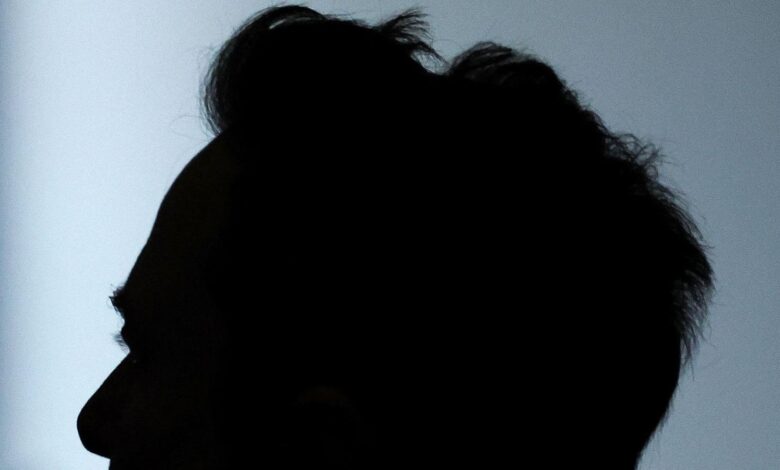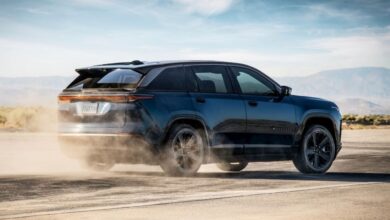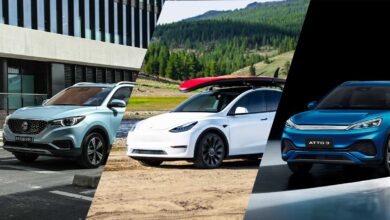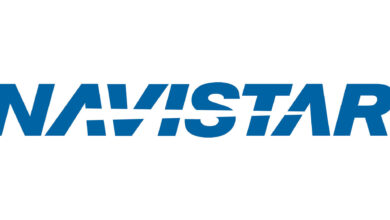Dr. Elon And Mr. Musk: Tesla’s Chaotic Robotaxi Pivot

TOBY MELVILLE/POOL/AFP/GETTY IMAGES
The impulsive billionaire calmed investors with plans for cheaper EVs that he previously backburnered. Then he muddled the story by cutting its fast-growing EV charging service team as he prioritizes an autonomous ride business that doesn’t appear close to being ready.
By Alan Ohnsman, Forbes Staff
There’s a “Dr. Elon and Mr. Musk” aspect to Tesla’s CEO these days. When he speaks will it be the old-school, tech nerd full of big, world-changing ideas or the mercurial billionaire making whiplash pivots with a multibillion-dollar business? Dr. Elon successfully lands reusable rockets on barges and promises a sub-$30,000 electric car to help the masses fight climate change. Mr. Musk gets condemned by the White House for spreading antisemitic conspiracy theories on a social media platform he overpaid for and prioritzes a $100,000 Cybertruck that’s recalled five months after launch.
It was mostly the former when Tesla’s CEO pacified jittery investors and cheered equity analysts on last week’s earnings call with modified plans for cheaper electric vehicles first promised in 2006 but not yet delivered, followed by a surprise trip to Beijing to gain approval to market the company’s driver-assistance features to Chinese consumers. Then, after laying off 10% of the company, including key executives, last week, he inexplicably expanded the job cuts further by slashing the team running its Supercharger network, a bright spot amid otherwise dismal first-quarter results, and dismissing the head of new products.
The dissonant moves seem to underscore Musk’s goal of pivoting the world’s benchmark EV brand to a company selling robotaxi rides instead of cars, a recurring topic for years that’s gained intensity of late. It’s a risky ploy as it’s far from clear Tesla can pull that off or if it will generate the financial benefits he anticipates — especially since it doesn’t appear Tesla has done fully autonomous testing on the level of Waymo or Cruise.
“The way to think of Tesla is almost entirely in terms of solving autonomy and being able to turn on that autonomy for a gigantic fleet,” he said on the April 23 earnings call. “If you value Tesla as just an auto company … fundamentally, it’s the wrong framework. If somebody doesn’t believe Tesla is going to solve autonomy, I think they should not be an investor in the company. But we will and we are.”
His track record suggests otherwise. Tesla’s current Autopilot and Full Self-Driving (FSD) features have been linked to 13 fatal crashes. Despite the features’ names, the company warns customers to monitor their vehicles at all times because they aren’t truly autonomous. Last week, the National Highway Traffic Safety Administration excoriated Tesla for “insufficient” steps taken to ensure that drivers pay attention while using those features. And compared to driver-assistance software offered by rival carmakers, Tesla is an “outlier” in its approach, “mismatching a weak driver engagement system with Autopilot’s permissive operating capabilities,” NHTSA said.
Tesla CEO Elon Musk seeks to launch the company’s Full Self-Driving software in China.
Future Publishing via Getty Images
Fully autonomous robotaxis are even tougher. Alphabet Inc.’s Waymo has poured billions into the development of fully self-driving technology for over a decade and is just now ramping up its commercial expansion to a fourth U.S. city, after successful startups in Phoenix, San Francisco and Los Angeles. Amazon’s Zoox unit plans to begin operating commercial robotaxi service in Las Vegas this year. Without similar pilot or test programs, Tesla appears undeniably far behind.
Never Say Never
“Never say never, because with the right resources and enough effort maybe they could at least get on par with Waymo,” said artificial intelligence expert Missy Cummings, a George Mason University professor who recently served as an advisor to NHTSA on autonomous vehicles. “I don’t see it happening. Not in any near-term timeframe.”
Tesla’s robotaxi plans: “I don’t see it happening. Not in any near-term timeframe.”
Musk has long been hailed as a tech visionary for disrupting the auto and aerospace industries with profitable electric cars and reusable rockets. Yet for every breakthrough like Tesla’s top-selling Model Y or SpaceX’s satellite-based Starlink internet system, there’ve been failures and flops, including plans for EV battery swap stations, solar roofs, Hyperloops and an autonomous robot that ended up being a dancer in a robot suit and, it appears, the new Cybertruck.
The disastrous $44 billion Twitter acquisition, in which Fidelity has marked down the value of its stake by 71%, is just one of a number of confusing business decisions Musk has made in the last year. Another is plowing billions into the Cybertruck instead of prioritizing a lower-cost, mass-market EV, which he has promised investors for years. Not only has the vehicle had a slow launch — every unit has been fully recalled for a defect causing the accelerator to stick — it’s unlikely to buoy Tesla’s flagging sales. Tesla has said there are no plans to sell it outside the U.S. at this time, likely because its weight and design prevent it from being sold to consumers in Europe or China, the company’s second-largest market.
Slashing Tesla’s Supercharger team is another perplexing move. The unit helped boost the company’s service revenue jump 25% to $451 million in the first quarter, per an SEC filing, after Musk opened the network to non-Tesla EVs this year. It’s widely been seen as a cornerstone of the U.S.’s electric vehicle infrastructure plan, allowing Musk, a strident critic of the Biden Administration, to cash in on $17 million of federal grant funds.
Following news of the cuts, Musk tweeted “Tesla still plans to grow the Supercharger network, just at a slower pace for new locations and more focus on 100% uptime and expansion of existing locations.”
Tesla employees were stunned by the move. “@elonmusk has let our entire charging org go. What this means for the charging network, NACS, and all the exciting work we were doing across the industry, I don’t yet know,” tweeted Will Jameson, previously the unit’s strategic charging programs lead. “What a wild ride it has been. News of the cuts also triggered a 5.6% drop in Tesla shares on Tuesday to $183.28.
Similarly, Musk’s decision to proclaim that Tesla is more an AI and robotaxi company than a carmaker complicates how consumers see the Tesla brand and the products that are core to its current business.
“It’s a shocking statement,” said Greg Silverman, a global director for Interbrand, which tracks and rates public perception of top corporate brands. “The time, the hassle and the economics of getting a solution where you can be a robotaxi company are humongous. They’re probably even more complicated than the electric vehicle evolution.”
Pursuit of Autonomy
Musk has eyed autonomous driving since he claimed in 2016 that Teslas were being built with all the cameras, sensors and computing power they needed to drive themselves. That’s not proven accurate, and even with eight years of software and hardware modifications, the company has only achieved what Musk referred to last week as “supervised full self-driving” – meaning a human driver must be ready to take over at any moment.
Musk’s renewed focus on turning Tesla into a robotaxi powerhouse coincides with a steep drop in vehicle sales in the first quarter and Cybertruck’s slow, problematic launch. Global EV price competition is intensifying, particularly from cheaper models sold by China’s BYD, putting pressure on Tesla’s profit margins. By contrast, the economics of a robotaxi business that uses a relatively small fleet of vehicles to ferry huge numbers of fare-paying passengers is attractive. A single Tesla plant could build all the vehicles it would ever need!
Elon Musk via X
But along with the overwhelming technical challenges, the near-term revenue potential from a Tesla robotaxi business is murky. “We continue to view robotaxi as a meaningful opportunity that provides considerable upside to the stock, but view it as several years out, and refrain from baking it into our model currently given large uncertainties around regulatory, operational and technical challenges,” Emmanuel Rosner, a Deutsche Bank equity analyst, said in a research note.
Even the added revenue Tesla could see from the availability of its FSD system in China, which helped the stock surge 15% on Monday, won’t be dramatic. In the U.S., it dropped the price of the software to $8,000 and charges a $99 monthly subscription fee. Assuming pricing in China is similar, that revenue could top $2 billion annually by 2030, according to Bank of America analyst John Murphy. That’s less than a tenth of Tesla’s sales in 2024’s first quarter.
Autopilot & FSD ≠ Autonomy
Tesla is also facing legal challenges around the way it markets its so-called “self-driving” features. Despite Musk’s boasts about Tesla’s AI prowess, regulators including California’s Department of Motor Vehicles are taking Tesla to court over his decision to name these features “Full Self-Driving” and “Autopilot,” arguing they overstate its abilities to public detriment. The company has faced similar challenges in Germany for years.
“The DMV launched an enforcement action against Tesla’s manufacturer and dealer licenses for alleged misleading and false advertising with regard to the company’s use of the terms Full Self-Driving and Autopilot,” the agency told Forbes. “Safety demands that the driving public be accurately informed of the system’s capabilities.”
California’s Department of Justice is pursuing the litigation, with a hearing scheduled for Sept. 9, 2024, the DMV said, declining to provide further details.
Tesla hasn’t reported self-driving test miles in California since 2019. Meanwhile, transportation agencies in Arizona and Nevada, other key test sites for autonomous vehicles, say they haven’t been contacted by the company about testing.
Tesla has a permit to test autonomous vehicles with a safety driver in California, as do dozens of other companies, but hasn’t reported test miles to the state since 2019, according to the DMV. To shift from testing to commercial service in the state, Tesla will need a deployment permit from the DMV (which the agency confirmed it hasn’t applied for) and approval from the California Public Utilities Commission.
Likewise, transportation agencies in Arizona and Nevada, other key test sites for autonomous vehicles, say they haven’t been contacted by Tesla. Texas, Tesla’s new home base, didn’t immediately respond to a request for comment on the matter.
Long Road To Robotaxis
After 15 years and billions of dollars for R&D and testing, Waymo is only now beginning to shift its autonomous driving tech to a more meaningful commercial phase. It operates hundreds of electric vehicles in Phoenix, San Francisco and Los Angeles – with no human backup driver at the wheel – that are providing “tens of thousands” of rides every week to fare-paying customers, the company said. It plans to expand its commercial ride service to Austin later this year.
A Waymo autonomous self-driving Jaguar robotaxi drives along Venice Beach in Los Angeles.
Getty Images
Waymo doesn’t share revenue figures, but assuming it books an average of 50,000 rides per week at $20 per ride in 2024, full-year revenue for the service at its current scale would top $50 million. And if it keeps improving the service, expands its fleet to tens or hundreds of thousands of vehicles and enters dozens more cities, that could quickly jump to billions of dollars annually. That’s what Alphabet is counting on and it’s the opportunity Musk covets.
But that big revenue payday is premised on robotaxis being safe. Last year General Motors-backed Cruise, Waymo’s top rival, halted the operation of its entire fleet in San Francisco and lost its license to operate a robotaxi service in California after one of its vehicles hit and dragged a pedestrian who’d been struck moments earlier by another car. Waymo has also had some accidents, including a minor collision with a towed vehicle in Phoenix and a robotaxi that struck a cyclist in San Francisco who’d been obscured by a truck. So far, however, its driverless vehicles haven’t caused major injuries or fatalities.
Tesla’s safety record with its current software, which requires someone to be behind the wheel, troubles some industry veterans. Musk’s insistence that Teslas can become fully autonomous simply using AI, reinforced by the company’s neural network and computing system, and camera-based computer vision, eschewing sensors like laser lidar and radar, isn’t a conventional view.
“My primary concern is Tesla lacks the patience and the technical approach necessary to safely launch truly autonomous technology on public roads.” said John Krafcik, Waymo’s former CEO
“My primary concern is Tesla lacks the patience and the technical approach necessary to safely launch truly autonomous technology on public roads,” said John Krafcik, Waymo’s former CEO and long-time head of Hyundai Motor’s U.S. auto business. “That puts the entire AV space at great risk.”
Neural Networks, Cameras, Hallucinations
AI expert Cummings doesn’t share Musk’s confidence in neural networks and cameras.
“There’s no way that any car can do the dynamic task of driving in any environment just using computer vision. It’s impossible,” she said, citing a scientific study she published on that topic. “It simply does not have the ability to sense the world correctly. Of all the systems on a self-driving car, computer vision is the least accurate. Radar can be pretty accurate. Lidar can be pretty accurate if it’s not raining. But for a car to rely solely on computer vision, people are gonna die.”
And despite Waymo’s status as the industry leader in autonomous driving, she’s also unconvinced it’s a technology any company can master soon, given the challenges AI systems have interpreting driving data.
“One of the problems is hallucinations,” she said. “You hear a lot about large language models and hallucinations, but computer vision systems literally hallucinate. They see things that aren’t there. This has been unsolvable.”
“We’re trying really hard to get over the hurdle of hallucinations in anything with a neural net. But we haven’t. We’re not even close.”.



